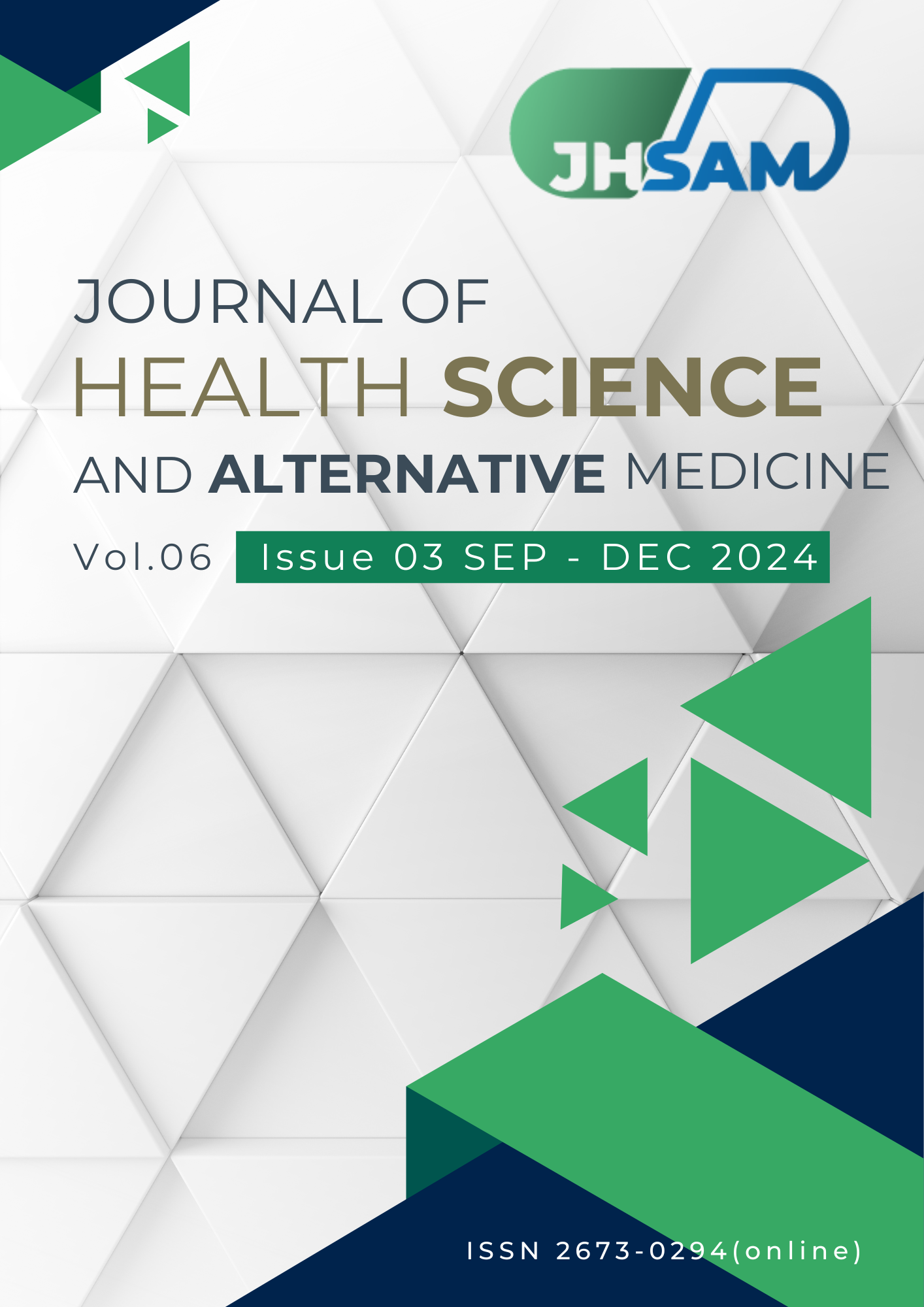Knowledge and Perceived Self-Efficacy Regarding Personal Protective Equipment for Coronavirus Disease 2019 Prevention: A Cross-Sectional Study among Thai Nursing Students at Suan Sunandha Rajabhat University
Main Article Content
Abstract
Introduction: Personal protective equipment plays a crucial role in preventing the transmission of Coronavirus Disease 2019 among healthcare workers as well as nursing students in clinical settings. The study aimed to investigate the level and relationship between knowledge and perceived self-efficacy regarding personal protective equipment for COVID-19 prevention among nursing students at Suan Sunandha Rajabhat University, Thailand.
Methods: An analytical cross-sectional study was conducted involving 144 undergraduate nursing students at a single faculty of nursing in Thailand between August and September 2022. An online questionnaire was administered to collect data on participants’ general characteristics, knowledge, and perceived self-efficacy regarding the use of personal protective equipment. Data were analyzed using descriptive statistics, the Chi-Square test, and Spearman’s rank correlation coefficient.
Results: Among 144 participants, a majority demonstrated high knowledge regarding the use of personal protective equipment (45.8%) while reporting moderate perceived self-efficacy regarding the use of personal protective equipment (45.1%). No statistically significant differences in the proportions of knowledge were found based on the participants’ study year (p-value = 0.499). However, there was a statistically significant difference in the proportions of perceived self-efficacy according to the participants’ study year (p-value = 0.013). Furthermore, knowledge was significantly positively correlated with perceived self-efficacy regarding the use of personal protective equipment (r = 0.24; p-value = 0.002).
Conclusion: The findings suggest a need for developing teaching and learning strategies to enhance nursing students’ proficiency in using personal protective equipment in alignment with current requirements.
Article Details

This work is licensed under a Creative Commons Attribution-NonCommercial-NoDerivatives 4.0 International License.
JHSAM publishes all articles in full open access, meaning unlimited use and reuse of articles with appropriate credit to the authors.
All our articles are published under a Creative Commons "CC-BY-NC-ND 4.0". License which permits use, distribution and reproduction in any medium,
provided that the original work is properly cited and is used for noncommercial purposes.
References
Meyerowitz EA, Richterman A, Gandhi RT, Sax PE. Transmission of sars-cov-2: a review of viral, host, and environmental factors. Ann Intern Med. 2021;174(1):69–79.
World Health Organization (WHO). COVID-19 epidemiological update - 19 January 2024 [Internet]. Geneva: World Health Organization; 2024 [cited 2024 Dec 2]. Available from: https://www.who.int/publications/m/item/covid-19-epidemiological-update---19-january-2024
Guo ZD, Wang ZY, Zhang SF, Li X, Li L, Li C, et al. Aerosol and surface distribution of severe acute respiratory syndrome coronavirus 2 in hospital wards, Wuhan, China, 2020. Emerg Infect Dis. 2020; 26(7): 1586–91.
Çelebi G, Pişkin N, Bekleviç AC, Altunay Y, Keleş AS, Ali M, et al. Specific risk factors for SARS-CoV-2 transmission among health care workers in a university hospital. Am J Infect Control. 2020; 48(10): 1225–30.
Nguyen LH, Drew DA, Graham MS, Joshi AD, Guo CG, Ma W, et al. Risk of COVID-19 among front-line health-care workers and the general community: a prospective cohort study. Lancet Public Health. 2020; 5(9): e475–83.
Sangsuwan J, Inchon P, Markmee P, Kanthawee P. Factors associated with COVID-19 preventive and control behaviors among people in high incidence border community, Thailand-Myanmar. J Health Sci Altern Med. 2023; 5(3): 17–24.
Reddy SC, Valderrama AL, Kuhar DT. Improving the use of personal protective equipment: applying lessons learned. Clinical Infectious Diseases. 2019; 69(Suppl 3): S165-70.
Hien PTT, Thuy LT, Hoai NTY. Barriers to adopting evidence-based practice: a cross-sectional study among undergraduate nursing students in Vietnam. Nursing Practice Today. 2024; 11(1): 44-52.
Fithriyyah YN, Alim S. Nursing student volunteers and their level of involvement during the COVID-19 pandemic: a systematic review. Frontiers of Nursing. 2024; 11(1): 23-37.
College of Nursing and Health, Suan Sunandha Rajabhat University. 2023 College of Nursing and Health undergraduate nursing curriculum. Samut Song Khram: Suan Sunandha Rajabhat University; 2023.
Bloom BS. Taxonomy of education objective: The classification of educational goals: handbook II: affective domain. New York: David Mckay; 1964.
Bandura A. Self-efficacy: the exercise of control. New York: W.H. Freeman; 1997.
Hossain MA, Rashid MU Bin, Khan MAS, Sayeed S, Kader MA, Hawlader MDH. Healthcare workers’ knowledge, attitude, and practice regarding personal protective equipment for the prevention of COVID-19. J Multidiscip Healthc. 2021;14:229-38.
Simak VF, Kristamuliana K. The relationship between knowledge of the use of personal protective equipment and the self-efficacy of Puskesmas Nurses against COVID-19 management. Int J Nurs Midwifery Sci. 2020; 4(2): 156-62.
Morasakul B, Punthasee P. Knowledge and prevention behaviors regarding COVID-19 among the first-year nursing students of Saint Theresa International College and Saint Louis College. Regional Health Promotion Center 9 Journal. 2021;15(37):179–95.
World Health Organization (WHO). Rational use of personal protective equipment for COVID-19 and considerations during severe shortages, 2020. Available from: https://www.who.int/publications/i/item/rational-use-of-personal-protective-equipment-for-coronavirus-disease-(covid-19)-and-considerations-during-severe-shortages
Trongrit T, Sakuntala S, Varinlada J, Tipsukon K, Jintaweeoporn P. Online social network usage behavior among nursing students of Boromarajonani College of Nursing, Songkhla. Journal of Nursing, Siam University. 2020; 21(41): 67–77.
Stikes BP, Husada Blitar P. The correlation of knowledge and self-efficacy in preventing the spread of pulmonary tuberculosis. Jurnal Ners dan Kebidanan. 2017;4(3):235–8.


